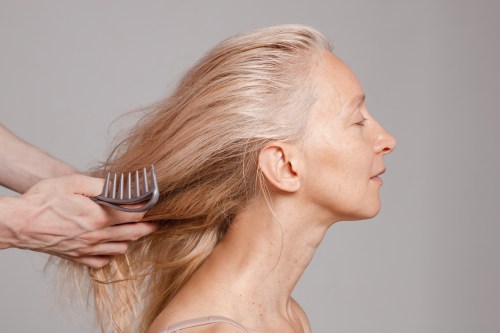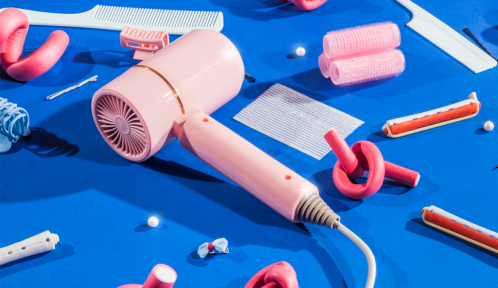There Are Two Types of Hair Thinning—Here’s How To Figure Out What You’re Dealing With
There are two common types of hair thinning, and each requires a different course of treatment. Here's how to know which you're dealing with.

Hair thinning, while common, can be incredibly overwhelming—especially if you’re dealing with it for the first time. But before you hit the panic button (and invest in a whole bunch of products that may not actually work), we want to arm you with as much information as possible to reassure you that the situation is far more manageable than it may seem.
What most people don’t realize is that there are actually two different types of hair thinning—reactive and progressive—that each have different causes and remedies. And knowing which one you’re dealing with is key to keeping your strands as healthy and full as possible.
“Reactive hair thinning, also known as telogen effluvium (TE), is an excessive increase in daily hair fall that’s due to an internal trigger,” explains Anabel Kingsley, consulting trichologist and brand president at Philip Kingsley Trichological Clinic in New York City. Progressive hair thinning, on the other hand, is caused by “various factors, including genetics, hormonal changes, and age,” explains double board-certified plastic surgeon Hardik Doshi, M.D., FACS, at Ample, a hair restoration studio in New York City.
Below, the pros break down how to tell the difference between these two types of hair loss, and—more importantly—how to treat them both.
Reactional hair thinning
What is reactional hair thinning?
“Reactive hair thinning, also known as telogen effluvium, is a type of hair loss marked by sudden and transient hair loss,” says Dr. Doshi.
Each hair follicle goes through three stages of growth—an active growth phase (anagen), a transitional phase (catagen), and a resting phase (telogen). Telogen effluvium disturbs this cycle by causing a greater proportion of hair follicles to enter the telogen phase too soon. This results in increased hair shedding and noticeable hair thinning.
It’s normal to lose up to 100 hairs per day, but with TE, you may see as many as 300 falling out daily.
What causes reactional hair thinning?
Kingsley outlines that the most common causes are stress, rapid weight loss, thyroid imbalances, vitamin and mineral deficiencies, surgery, pregnancy, and high fevers. Remember the stress hair loss that seemingly everyone was dealing with during and after the pandemic? Well, that was reactional hair thinning.
With that in mind, it’s important to note that the effects of TE don’t show up right away. Due to the nature of the hair growth cycle, it can take anywhere from 6-12 months after the triggering event for the hair to fall out.
How to treat reactionary hair thinning
While TE is incredibly distressing, it’s important to note that it’s not permanent or progressive—which makes treating it pretty straightforward.
“TE due to an illness or a period of stress is usually self-limiting, and will correct itself without treatment,” says Dr. Kingsley. “In instances where hair shedding is due to an underlying imbalance, once the cause is found and addressed, hair loss will stop, and strands will grow back as before.” In other words, once you figure out what’s behind the shedding and treat that, the hair loss should resolve itself on its own.
For example, one of the most common TE triggers in women is ferritin (stored iron) deficiency, and in these cases, taking an iron supplement and making dietary tweaks will likely help get things back on track. Poor scalp health is another common culprit, and using scalp-care products specifically targeted to hair growth can foster a better environment to combat thinning.
Progressive hair thinning
What is progressive hair thinning?
“Progressive hair thinning is commonly used to describe a gradual and persistent reduction of hair density over time,” says Dr. Doshi. This is a typical symptom of androgenetic alopecia, commonly known as male or female pattern baldness.
Androgenetic alopecia is a hereditary condition that affects both men and women, although the pattern of hair loss varies. In men, progressive hair thinning often begins in the late teens or early twenties with a receding hairline and crown thinning that forms a distinctive M shape. Women experiencing androgenetic alopecia may observe scattered hair loss on the scalp rather than a distinct receding hairline. Thinning usually happens later in life, typically after menopause.
What causes progressive hair thinning?
“Various factors contribute to progressive hair thinning, including genetics, hormonal changes, and age,” says Dr. Doshi. “Hormones, especially dihydrotestosterone (DHT), play a crucial role in the development of androgenetic alopecia in genetically susceptible individuals.”
How to treat progressive hair thinning
Similar to telogen effluvium, treating progressive hair thinning should also involve optimizing your diet, managing stress levels, and maintaining a healthy lifestyle. However, you will also need to use medicated products to halt its progression and encourage regrowth.
For female pattern baldness, Dr. Doshi usually recommends topical minoxidil, a drug widely used to promote hair growth. Hormone replacement treatments may also be considered for postmenopausal women whose hormonal fluctuations may be contributing to hair loss. And while it’s not quite as common for women as it is for men, hair transplant surgery can be used as a final resort to restore hair density if the more tried-and-true methods aren’t delivering results.
How to identify which type of hair loss you’re dealing with
If you observe a sudden and significant shedding, you’ve most likely got a case of telogen effluvium on your hands. On the flip side, if you observe a gradual decrease in hair density where your scalp is becoming more visible, and your hair is finer and more sensitive, it’s probably progressive hair loss.
That said, it is possible for both telogen effluvium and progressive hair thinning to occur simultaneously. Therefore, it’s always a good idea to consult with a trichologist or dermatologist as soon as you notice that there is a problem.
Sign Up for Our Daily Newsletter
Get all the latest in wellness, trends, food, fitness, beauty, and more delivered right to your inbox.
Got it, you've been added to our email list.










